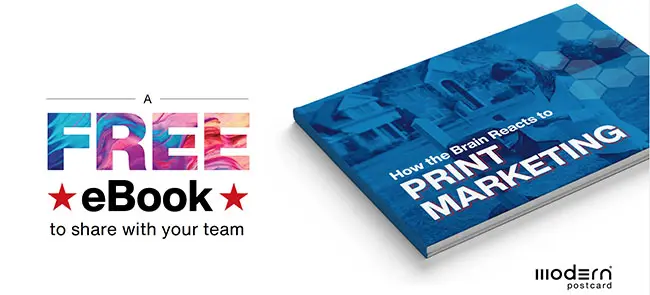Direct Mail Marketing Tips for New Marketers

Marketers New to Direct Mail Should Take Advantage of These Direct Mail Marketing Tips and Tricks
Understanding these fundamental Direct Mail marketing tips helps new marketers acquire more skills and have more impact when promoting their business.
Direct Mail is a combination of knowing your audience, assembling a list, developing the creative, message, and copy, and then adding a powerful and compelling call-to-action and offer. Yet many marketers or business owners new to Direct Mail have a difficult time getting started.
The most common marketing for any business is a combination of digital platforms like email, Social Media accounts, and a website. With this digital foundation, a small business owner or marketing manager can get started with basic digital promotion and advertising. Thus many newer marketers are “digital natives” and have little experience using Direct Mail.
Using Direct Mail doesn’t have to be hard or complicated, and it can be incredibly effective when done right. These tips will help make it easy to prepare and launch a program that works for your business.
What are the Strengths of Direct Mail?

Direct Mail is Physical Marketing
In a world of thousands of digital marketing impressions per day, email and social media posts can easily be overlooked or scrolled over. Also, with email opt-out rates increasing, ad-blocking software affecting 30% of devices, and Mac iOS changes reducing the app tracking rates, it’s getting harder to lift response rates with digital marketing.
Conversely, Direct Mail response rates have been holding steady, and even increasing. A big part of the reason is that the physical, tactile nature of Direct Mail makes it stand out among other marketing touches. FMRI studies have proven that the human brain responds with more engagement to physical and tactile marketing.

For more about How The Brain Responds to Print Marketing, read the associated eBook and watch the webinar-on-demand. In these assets, you’ll also learn more Direct Mail marketing tips and tricks to help you take advantage of this physical marketing.
Direct Mail is Highly Targeted Directly to Individual People
Direct Mail is targeted and delivered to a mailing list of real people with home addresses. Unlike many digital advertising channels that use an algorithm based on audience parameters to display in a device, Direct Mail advertising reaches the actual person. This big advantage gives you hyper-control over who is actually receiving your marketing touch.
Most Direct Mail advertising tips will note that the mailing list is the first place to spend time and attention. Studies indicate that the mailing list itself is responsible for 40% of the response rate, and getting the right list of the right people takes full advantage of Direct Mail marketing.
Mailing lists are available for virtually any type of prospect you’re trying to reach. There are thousands of data sources that connect credit card activity, catalog subscriptions, behaviors and interest, age and home value, gender and income, you name it. What that means is that any business can gain access to the exact kind of buyer they’re looking to reach.
In addition, you can use an existing customer or lead file to create prospect lists. This is called a “look-alike audience,” where you use the modeling of age, income, gender, and other attributes of your best customers to find prospects who look like them. That way, you’re prospecting based on higher intelligence of who is more likely to respond.

Direct Mail Has Been Proven to Drive High Response
Direct Mail has consistently yielded high response rates for decades, while email response and opt-out rates fluctuate and digital advertising response rates have declined. Response rates are comparatively higher than digital marketing, especially for prospecting. In addition, Direct Mail has been proven throughout numerous studies to yield a higher brand recall than digital ads.
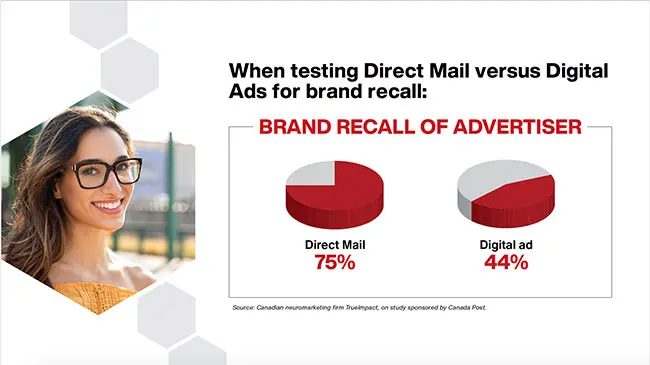
Meanwhile, Direct Mail’s average response rate is between 2.7% and 4.4%, compared to email’s 0.6% response rate. This means that for 10,000 people receiving a Direct Mail piece, about 270 to 440 people would respond, compared to only 60 responses from an email.
These statistics on Direct Mail response rates show the ways you can compare the costs and responses from Direct Mail to best plan a marketing program.
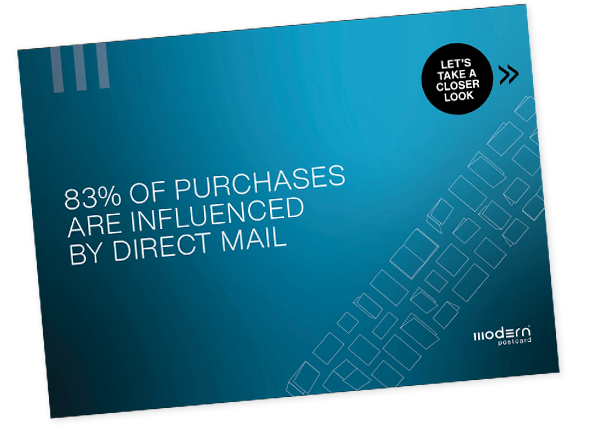
Direct Mail Is Visual
Direct Mail is unique in that your customers hold the piece in their hands and can take time to read, flip it over, place it on a table, etc. Unlike YouTube pre-roll videos or other digital display ads, recipients can spend more time engaging with the actual promotion. Cleverly using photos, illustrations, typography, and other graphic elements will create stopping power and garner attention and interest.
Our Direct Mail postcard design tips have examples of strong, high-quality photos or images on the frontside of the cards. That simple technique engages the viewer and pulls them in to read the copy and consider the message and offer you’re promoting.
The visual hook of the piece is meant to move the recipient from awareness to interest, and then the copy and other visual cues get them towards consideration. And then finally, your offer and call-to-action move them to respond.
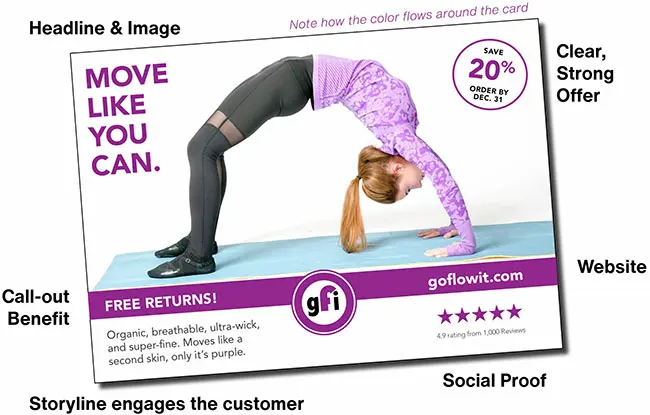
Direct Mail Is Easy to Integrate With Digital Marketing
Direct Mail works alongside digital marketing to add credibility, frequency, and variety to marketing programs. When Direct Mail is paired with emails to a subscriber list, response rates usually jump because most open rates for email is 20% to 30%, meaning 70% to 80% don’t ever open the email at all. Meanwhile, postcard Direct Mail has up to a 90% open rate – your recipient can’t miss seeing the card when pulling it out of the mailbox.
When using CRM data, pairing a mailing along with an email, and vice-versa, is a proven way to reach an audience with different channels. In addition, adding a QR code creates more digital interaction. It’s a fast way for a recipient to go directly to the call-to-action landing page or conversion you’re using.
With Integrated Direct Mail programs, you can send Facebook, Instagram and Google Display Ads to the devices of the people on the mailing list, ensuring that your prospects get a blend of Direct Mail and 8-16 digital marketing touches in a month, lifting response rates even more.
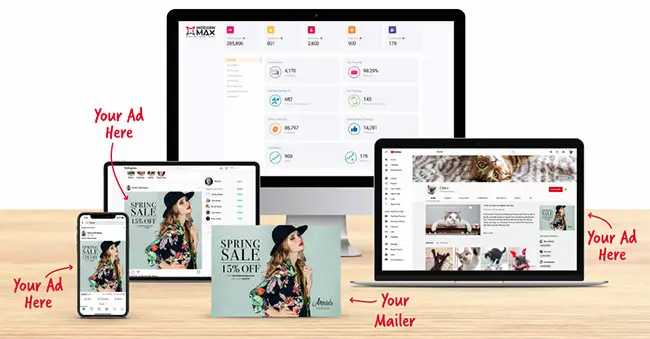
What are 3 Key Fundamentals to a Successful Direct Mail Marketing Promotion?
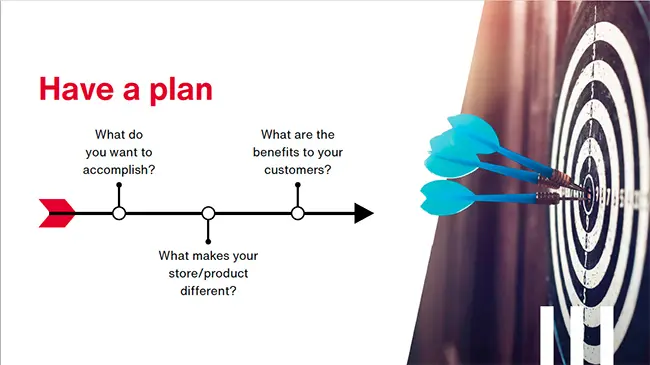
Planning the Direct Mail Program
All Direct Mail programs must begin with a plan, and it’s best if it’s written down. By carefully detailing the list parameters, messaging, how the promotion will drive action, creative hooks, the offer, and any digital or cross-channel integration, you will better set your program up for success.
The best way to structure a plan is to have sections for:
- Goal – This is what you want the mailing to specifically accomplish. This is its job. Is it to create leads? Website visitors? Trade show visits? Actual purchases? Awareness? The goal helps to drive all the other decisions.
- Audience – This is best planned out as a description of the person you’re trying to reach. Remember that it’s not a device, but a real person. Who are they? How do they fit into your sales cycle? What about them makes them a good candidate for your business? Remember that not everyone can be your best customer. From the audience, you can build the right list.
- Messaging & Creative – What is it that you’re trying to tell the audience, and how is it different than your competitors? Using attention-grabbing headlines, clear and concise copy, and a mix of paragraphs, bullets, headlines and subheadlines will add more variety to the phrasing and create more interest for the recipient. There’s more detail about the creative approach below.
- Integration With Other Marketing – Creating an Integrated Direct Mail marketing program is more important than ever, since customers expect to see marketing in a variety of ‘channels.’ Planning how the headline, images, and offers connect and interact with digital tactics will give your program more well-rounded presence, and deliver a stronger impact.
For more Direct Mail strategy tips we recommend you watch our Direct Mail 101 webinar, or if you’re in the area, attend one of our FREE Direct Mail Crash Course seminars.
Determine the Ideal Mailing List
The Mailing List is the secret ingredient that makes your Direct Mail inherently different than anything your competitors are doing. Competitors can try to copy your messaging and imagery, even your offers, but you have complete control of whom you’re mailing to. It’s an incredibly powerful moment when you can see the list of real people on a mailing list, knowing that they will be receiving your Direct Mail marketing.
Mailing lists are usually segmented into broad categories based on the kind of audience you’re targeting:
- Consumer – The variety of lists available to reach different kinds of consumers are almost endless. These also include Specialty Lists that pinpoint magazine subscriptions, behavior, interest, credit card transactions, and more. Marketers can find their ideal prospects from out of over 200 million consumers targetable with Direct Mail.
- Business to Business (B2B) – There are vast resources to find companies that fit your ideal audience profile. Parameters like employee size, revenue, industry, and more, are all used to home down to a specific group of names, titles, and business addresses.
- Occupancy Lists – Perfect for local mailings where you don’t need an actual name, these pieces arrive to “Current Resident” in a neighborhood. Targeting by radius around a location, ZIP code and/or mail carrier routes, and more, this approach gives marketers the chance to more affordably saturate a specific group of households.
- New Movers and New Homeowners – These curated lists pull all the recent movers or homeowners in a given ZIP code or radius. Continually refreshed, these names and households can be targeted by recency, home value, income, and more.

One of the best ways to start building a list is to generate a Customer Profile Report. This approach takes your best customers and finds their demographic, interest, and behavior profiles that can be indexed and then matched to specific mailing lists. The mailing equivalent to a digital “look-alike audience,” this uses actual household data to enhance any current customer list to help find the prospects most likely to respond.
Strategize the Creative Approach
Like we mentioned earlier, Direct Mail is physical, interactive, and can have multiple features to play with like different sizes, folds, sides, panels, envelopes, letters, pull-ups, tabs, and more. You can review our Direct Mail marketing tips template or see examples of postcards designed for high response and engagement. The creative elements of Direct Mail are varied, and should be written out as you consider what kind of piece will work best.
- Format – postcards, letters, booklets, catalogs, folded postcards, etc., are all different kinds of shapes, sizes, and types of mail that can be sent.
- Quality Paper – This is such an important yet often-times overlooked part of the overall presentation. Remember that your brand will be reflected by the quality of the touch and experience, and cheap paper makes your business look poor.
- Imagery – Make sure that you’re using the right mix of dramatic photos, colors, and graphics to align with your branding. Using high-resolution imagery is essential in making a strong, professional impact. Images of people usually engage, but the most important aspect is quality and stopping-power of the image.
- Headline – Use a handful of words to make a concise, easy-to-read headline. Think of it like a billboard, where you have a handful of seconds to grab someone’s attention and keep it, so they can experience the rest of the Direct Mail piece.
- Body Copy – A storytelling approach is an effective and classic way to construct the copy: Set up the challenges the recipient faces. Tell them how your business can help them overcome the challenge. Show them how they transform into something more after working with you. Use both long and short sentences for more variety. Avoid the passive tense, and have a consistent rhythm. Think of it like a brief ‘elevator pitch’ on a card.
- Offer – Make sure the offer is compelling and different than what you’re giving away on the website or with an email subscription. And, have an expiration date that is reasonable for the recipient to take advantage of, yet still timely to create a sense of urgency.
- Call to Action – This small and important nugget actually tells the recipient what you want them to do, how to do it, and moves them to the next stage of the buying cycle. Call, Visit the Website, Learn More, Download, Scan the QR Code, Order Now…these are all classic Calls-to-Action, and tell your prospect exactly what to do next. Make sure to include your phone and website!
These fundamentals should kick-start your Direct Mail program. And to make your Direct Mail more effective, contact us at Modern to help you plan frequency, variety, and consistency in your approach.


